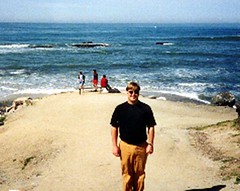When I saw State of Play I first thought to myself wow I'm seeing the death of newspapers and of the genre of newspaper movies played out in almost real time as papers in Denver and Seattle vanish and The Globe and The Sun-Times are under real threat. Elsewhere I wondered aloud if I would ever see another great Hollywood presses rolling/newspaper printing/front pages scrolling classical montage to which my college housemate Kyle justly retorted, "Yes! It's called The Soloist." Oops! I did go see that movie within the week. I think, however, the larger point remains true. We are at, for lack of a better term, a Tipping Point with respect to print journalism in the US. Whatever newspapers will remain and for how long is very much up in the air. Of course the notion of the death of this particular movie genre is not new. It's been around since at least 2006.
So in honor of the topic I'd like to take a little trip down memory lane and consider one o Hollywood's greatest singular inventions: the genre of the Newspaper movie from The Front Page and His Girl Friday through Libeled Lady to Ace in the Hole AKA The Big Carnival to The Fortune Cookie to All The President's Men right on through to The Paper and Zodiac. And then of course, there's Welles' Kane!
First let's begin with a definition because "that's a very good place to start." We can roughly divide newspaper movies into two large categories: 1) the classic genre really taking off in the 30s and 2) the modern paranoid thriller staple of so many of the 1970s best films. There is no clear cut dividing point between the two types, although we can be said to be venturing from one to the other during the 1950s in approximately the time period between Billy Wilder's 1951 Kirk Douglas classic Ace in The Hole (the style of the reporter is definitively old school but his story smacks of the new tabloid journalism) and the 1957 Burt Lancaster/Tony Curtis vehicle Sweet Smell of Success, with again a prototypical star columnist in JJ Hunsecker who looks back to such characters as Waldo Lydecker in Laura and Sheridan Whiteside in The Man who Came to Dinner, themselves both thinly veiled versions of the New Yorker critic Alexander Woollcott. Here again a classic early newspaper figure has been linked to a coming modern "fad", the jazz guitar stylings of Steve Dallas (Martin Milner), who is unfairly tarred as a dope smoking Communist in another newspapers different gossip column in a tip planted by press agent Sidney Falco (Curtis) during the films' noirish revenge plot.
The basic elements of the classic type of a Hollywood newspaper movie:
At least one super wisecrackin' ace reporter often with a cool Fedora featuring something stuck in the hatband. More classically a bickering couple of reporters straight out of Shakespeare's Beatrice and Benedick giving the lie to Cavell's notion of the "Hollywood Comedy of Remarriage." The language is crystal and sharp and spoken at an incredible pace. Do people really talk like that? No, they do not! But you'd do well to imitate this dialogue in your written prose. Finally there's almost always a classic Hollywood montage involving a rolling printing press and a rapid succession of headlines and/or scrolled front pages. As Thomas and Vivian C. Sobchack note, "in the United States, montage came to mean a series of shots, often with superimpositions and optical effects, showing a condensed series of events, for example a crime wave in a a city" (486). The classic trifecta: It Happened One Night, His Girl Friday, and The Philadelphia Story. Well the latter is about a scandal rag rather than a newspaper proper, but it's more or less the same thing. And Spy magazine is printed Tabloid-style.
The ultimate outlier: Citizen Kane, totally sui generis. Note in the two textbooks referenced below the examples of Hollywood montage both come from Kane and both involve newspapers. Kawin (100) focuses on the famous Susan's operatic career sequence with competing newspaper headlines, all bombs except Kane's The Inquirer, which is drinking the home brew. Similarly the Sobchack's focus (122-23) on the justifiably famous compressed aging at the breakfast table sequence, where Kane and his now wife Susan read different newspapers to signify the distance growing between them, something which is physically replicated in the later shots of the montage.
For the latter style: think the classic paranoia fantasies of the 1970s. Reporters become everymen and heroes of the depressed and downtrodden fighting back against implacable invisible foes (The Tri-Lateral Commission, anyone?). Government is absolutely corrupted and life sure ain't what it used to be. A trifecta: All The President's Men, The Parallax View, and Network. As above the last one is part and parcel of the genre while in fact being about a different medium of communication all together. But we're still "Mad as hell" and we're "not gonna take it anymore!"
A Short Chronological List of Good Newspaper Movies Not Already Referenced Above:
How Men Propose (1913)
Platinum Blonde (1931)
The Front Page (1931, 1974)
I Cover The Waterfront (1933)
Foreign Correspondent (1940)
Meet John Doe (1941)
Woman of the Year (1942)
The Big Clock (1948)
Deadline USA (1952)
Teacher's Pet (1958)
Continental Divide (1981)
Absence of Malice (1981)
The Year of Living Dangerously (1982)
The Killing Fields (1984)
Salvador (1986)
Switching Channels (1988)
I Love Trouble (1994)
Welcome to Sarajevo (1997)
Never Been Kissed (1999)
Bibliography
Stanley Cavell, Pursuits of Happiness: The Hollywood Comedy of Remarriage. Harvard Film Studies. Cambridge, MA: Harvard UP, 1981.
Bruce F. Kawin, How Movies Work. Berkeley: U of CA P, 1992.
Richard R. Ness, From Headline Hunter to Superman: A Journalism Filmography. The Scarecrow P, 1997.
Thomas Sobchack and Vivian C. Sobchack, An Introduction to Film. 2nd ed. Boston: Little, Brown & Co., 1987.
Thursday, May 07, 2009
Subscribe to:
Post Comments (Atom)

No comments:
Post a Comment